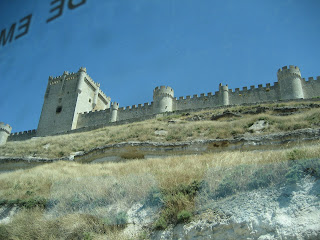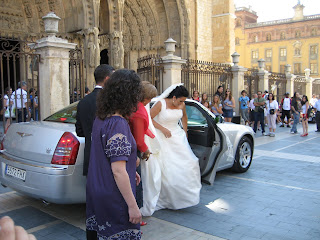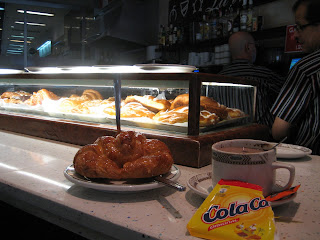




Hello all!
Yesterday I went on a trip to the cities of Cáceres y Trujillo, which are both located in the region of Extremadura. That's to the south of Salamanca, and it is known for its extreme climate. Hence, it was very hot.
We drove about 3 hours to Caceres first, and it was a very pretty ride. Cáceres is a very old city, which was conquered and reconquered time and again by the Romans, Arabs, Christians, and it switched hands a number of times. It is filled with beautiful old palaces, cathedrals, and what should be a beautiful Plaza Mayor, though it is currently under construction. It is also a very hilly town, and we were going up and down a lot. We ate lunch there, too. It was interesting, because my friend and I scoped out the restaurants around the Plaza Mayor, and they all had pretty much the same things on the menus (10 euros you get an appetizer, a main course, dessert, bread, and water or wine), so we sat at the one that looked the best.
Midway through the meal, at the restaurant to our left, there was lots of yelling going on, and we heard some customers calling the food and restaurant "
mierda." The waitress threatened to call the police, and the customers remained there. Five minutes later, the police arrived! Again, lots of yelling, both the police and the customers were smoking cigarettes, and then apparently the police asked one of the guys for his ID. He refused, and they threatened he could go to jail. Then it was quiet again, and the police left. Again, the belligerent customers remained at the restaurants. A few minutes later, the police came back again. It was a very confusing situation, and we asked our waitress what was going on over there, and she said this hardly ever happens, usually only in the bars later at night, and that the police in this town were very mild. At that point, we had to meet back up with our group again to go to Trujillo, so I'm not really sure what was the conclusion, but it was interesting. Also, the food we had that afternoon was delicious. I ate
paella, pollo asado con patatas fritas, torta de chocolate, y agua y pan. Mmm. :)
So then we went to Trujillo. It was a really nice, small, tranquil city. If you've ever noticed how many cities of Trujillo there are in Latin America (you probably haven't), it's because this is the hometown of Francisco Pizarro. Again, Spain is very proud of its conquistador past, and in the Plaza Mayor, there's a giant statue of him. Pizarro is remembered for conquering the Inca empire and establishing Lima, Peru.
I was very excited to learn that Trujillo is also known for its giant Cheese Festival!! Unfortunately, it's held in May, so I've missed it again this year, but apparently thousands of people come from all around Spain to showcase and eat their artesanal cheeses. I was very curious to try some of this famous cheese, but it is also not pasteurized, and I don't like to take unnecessary chances when I travel.
Notice the statues on top of the building from the Plaza Mayor. Two of the figures are noteworthy for doing, ahhem, interesting things.
Also, on the way back, our group was about 16 people, and on the way back, only 14. We left behind an older Japanese couple! The husband was very sweet, they were probably in their late 60s, and apparently the woman wasn't happy (she spoke in Japanese, not Spanish) and refused to get on the bus, so we left them! These tours are put on by the Universidad de Salamanca, and they mean business about being punctual and cooperative to keep the tour moving!
So we left, and after only about a half hour, we stopped at a rest stop. Apparently our radiator overheated, and so we were at the rest stop for an hour and a half, and the company sent us a minibus to take us the 3 hours back to Salamanca. Quite a day. :)





















































